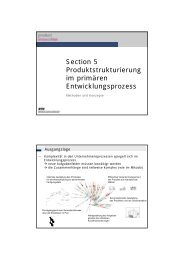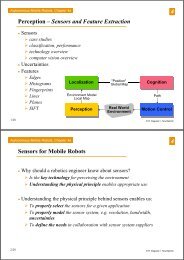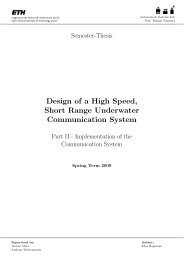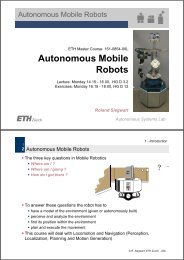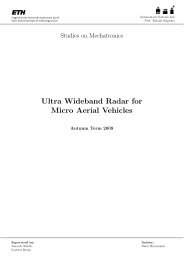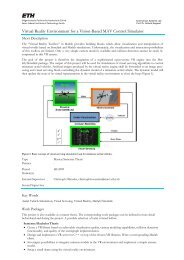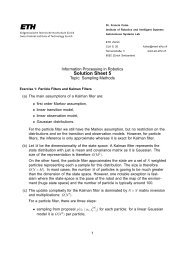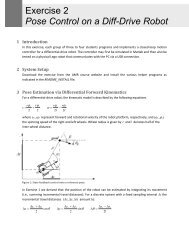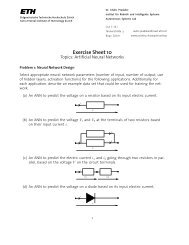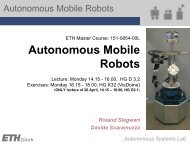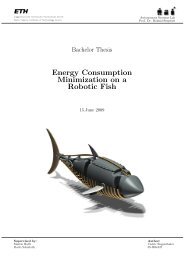Modeling of coaxial helicopters - eth
Modeling of coaxial helicopters - eth
Modeling of coaxial helicopters - eth
Create successful ePaper yourself
Turn your PDF publications into a flip-book with our unique Google optimized e-Paper software.
Unmanned Aircraft Design,<strong>Modeling</strong> and Control<strong>Modeling</strong> <strong>of</strong> Coaxial Helicopters(with a focus on classic rotor dynamics theory)Christoph Hürzeler
Course Contents— Part 1 - Introduction:— Goals <strong>of</strong> the Course— Overview <strong>of</strong> Coaxial Helicopters— General <strong>Modeling</strong> M<strong>eth</strong>odologies— Levels <strong>of</strong> <strong>Modeling</strong>— Part 2 – Rotorcraft <strong>Modeling</strong>— <strong>Modeling</strong> Introduction— <strong>Modeling</strong> Main Aerodynamic Forces— <strong>Modeling</strong> Blade Flapping— The Coaxial RotorUnmanned Aircraft Design, <strong>Modeling</strong> and Control - Rotorcraft 2
Part 1 – Goals <strong>of</strong> the Course— Know how to derive models for the most relevant effects— Better understand why and how <strong>helicopters</strong> work— Gain capability to read into more advanced topicsUnmanned Aircraft Design, <strong>Modeling</strong> and Control - Rotorcraft 3
Part 1 – <strong>Modeling</strong> Levels & M<strong>eth</strong>odologies— Blackbox— Identify input-output behavior— No understanding <strong>of</strong> underlying system— Greybox— Based on laws <strong>of</strong> physics— Identify model parameters— Whitebox— Purely based on laws <strong>of</strong> physics— All parameters predictedwww.johnson-aeronautics.comwww.continuum-dynamics.comUnmanned Aircraft Design, <strong>Modeling</strong> and Control - Rotorcraft 4
Part 1 – Coaxial Helicopters— All thrust forces used for lifting— No exposed tail rotor— Advantage in forward flight— Higher complexity rotor hub— Higher maintenance costAdvancingBladeRetreatingBladeReverseFlow RegionUnmanned Aircraft Design, <strong>Modeling</strong> and Control - Rotorcraft 5
Part 1 – Coaxial Helicopter Acuation Systems— Full-Scale:— Fixed RPM— Dual swashplate— Miniature-Scale— Varying RPM— Single swashplate &stabilizer bar— No collectiveUnmanned Aircraft Design, <strong>Modeling</strong> and Control - Rotorcraft 6
Part 1 – ASL Coaxial Helicopter History— The CoaX Family— muFly Prototypes— AIRobots CXUnmanned Aircraft Design, <strong>Modeling</strong> and Control - Rotorcraft 7
Part 1 – AIRobots CX Actuation SystemUnmanned Aircraft Design, <strong>Modeling</strong> and Control - Rotorcraft 8
Part 2 – Model Overview— Lower Rotor Block DiagramUnmanned Aircraft Design, <strong>Modeling</strong> and Control - Rotorcraft 9
Part 1 – Rotor Degrees <strong>of</strong> Freedom— Feathering („Pitch“)— FlappingUnmanned Aircraft Design, <strong>Modeling</strong> and Control - Rotorcraft 10
Part 1 – Rotor Degrees <strong>of</strong> Freedom— Feathering („Pitch“)— FlappingUnmanned Aircraft Design, <strong>Modeling</strong> and Control - Rotorcraft 11
Part 2 – Rigid Body DynamicsUnmanned Aircraft Design, <strong>Modeling</strong> and Control - Rotorcraft 12
Part 2 – Rigid Body DynamicsMomentumConservationAngular MomentumConservationUnmanned Aircraft Design, <strong>Modeling</strong> and Control - Rotorcraft 13
Part 2 – External Forces and MomentsGravity Thrust Hub Body DragForce ForceForce ForceThrust TiltMomentFlappingMomentHub ForceMomentRotorTorqueUnmanned Aircraft Design, <strong>Modeling</strong> and Control - Rotorcraft 14
Part 2 – Coordinate Frame Definition— {W}: World frame with origin O— {B}: Rigid body frame with origin S— {B‘}: Hub-wind frame with origin S‘— {H}: Rotor hub frame with origin N— {K}: Rotor flap frame with origin E— G: Rotor blade center <strong>of</strong> gravityUnmanned Aircraft Design, <strong>Modeling</strong> and Control - Rotorcraft 15
Part 2 – Special Case <strong>of</strong> the Hub-Wind Frame— {W}: World frame with origin O— {B}: Rigid body frame with origin S— {B‘}: Hub-wind frame with origin S‘— {H}: Rotor hub frame with origin N— {K}: Rotor flap frame with origin E— G: Rotor blade center <strong>of</strong> gravityUnmanned Aircraft Design, <strong>Modeling</strong> and Control - Rotorcraft 16
Part 2 – Blade Aerodynamics: Blade Element TheoryUnmanned Aircraft Design, <strong>Modeling</strong> and Control - Rotorcraft 17
Part 2 – Blade Aerodynamics: Blade ForcesRotor TorqueRotor ThrustUnmanned Aircraft Design, <strong>Modeling</strong> and Control - Rotorcraft 18
Part 2 – Blade Aerodynamics: Blade ForcesPr<strong>of</strong>ile DragInduced DragRotor TorqueRotor ThrustUnmanned Aircraft Design, <strong>Modeling</strong> and Control - Rotorcraft 19
Part 2 – Blade Aerodynamics: Blade ForcesRotor TorqueRotor ThrustUnmanned Aircraft Design, <strong>Modeling</strong> and Control - Rotorcraft 20
Part 2 – Blade Aerodynamics: Angle <strong>of</strong> AttackUnmanned Aircraft Design, <strong>Modeling</strong> and Control - Rotorcraft 21
Part 2 – Blade Aerodynamics: Lift and Drag Coefficients (1)Unmanned Aircraft Design, <strong>Modeling</strong> and Control - Rotorcraft 22
Part 2 – Blade Aerodynamics: Lift and Drag Coefficients (2)— Lift & Drag Polars for NACA 4412Unmanned Aircraft Design, <strong>Modeling</strong> and Control - Rotorcraft 23
Part 2 – Blade Aerodynamics: Blade Lift and DragRotor TorqueRotor ThrustUnmanned Aircraft Design, <strong>Modeling</strong> and Control - Rotorcraft 24
Part 2 – Blade Aerodynamics: Inflow Velocities (1)PerpendicularInflowTangentialInflowUnmanned Aircraft Design, <strong>Modeling</strong> and Control - Rotorcraft 25
Part 2 – Blade Aerodynamics: Inflow Velocities (2)RotorVelocityInflow dueto Pitch MotionLongitudinal InflowUnmanned Aircraft Design, <strong>Modeling</strong> and Control - Rotorcraft 26
Part 2 – Blade Aerodynamics: Inflow Velocities (3)InducedVelocityClimb/DescentRateRoll rateabout hub y-axisBlade FlapVelocityLongitudinal Inflowdue to FlappingUnmanned Aircraft Design, <strong>Modeling</strong> and Control - Rotorcraft 27
Part 2 – Rotor Forces & Torques (Connecting the Pieces)— Integrate over blade radius— Average over rotor azimuth— Sum over number <strong>of</strong> bladesUnmanned Aircraft Design, <strong>Modeling</strong> and Control - Rotorcraft 28
Part 2 – Rotor TorqueInduced DragPr<strong>of</strong>ile DragUnmanned Aircraft Design, <strong>Modeling</strong> and Control - Rotorcraft 29
Part 2 – Rotor TorqueUnmanned Aircraft Design, <strong>Modeling</strong> and Control - Rotorcraft 30
Part 2 – Rotor ThrustUnmanned Aircraft Design, <strong>Modeling</strong> and Control - Rotorcraft 32
Part 2 – Rotor Flapping MomentUnmanned Aircraft Design, <strong>Modeling</strong> and Control - Rotorcraft 33
Part 2 – Blade Flapping: Rotor Hub Designs— Fully Articulated— Teetering— HingelessUnmanned Aircraft Design, <strong>Modeling</strong> and Control - Rotorcraft 34
Part 2 – Blade Flapping: Linear Flap Spring ModelVirtual Hingewith SpringUnmanned Aircraft Design, <strong>Modeling</strong> and Control - Rotorcraft 35
Part 2 – Blade Flapping: Flapping Dynamics (1)— Derivation Procedure— Dettach Blade from Hub— Formulate Angular MomentumConservation Law for Blade Body— Extract Flap Dynamics— Introduce Steady-State Solution— Solve for Flap CoefficientsUnmanned Aircraft Design, <strong>Modeling</strong> and Control - Rotorcraft 36
Part 2 – Blade Flapping: Flapping Dynamics (2)Unmanned Aircraft Design, <strong>Modeling</strong> and Control - Rotorcraft 37
Part 2 – Blade Flapping: Flapping Dynamics (3)Flapping = Damped OscilatorUnmanned Aircraft Design, <strong>Modeling</strong> and Control - Rotorcraft 38
Part 2 – Blade Flapping: Flapping Dynamics (3)Flapping Frequency RatioLock NumberUnmanned Aircraft Design, <strong>Modeling</strong> and Control - Rotorcraft 39
Part 2 – Blade Flapping: Steady State FlappingSteady-StateFlapping ResponseForcing TermsFlapping Behavior Dominated by andUnmanned Aircraft Design, <strong>Modeling</strong> and Control - Rotorcraft 40
Part 2 – Rotor Flapping MomentUnmanned Aircraft Design, <strong>Modeling</strong> and Control - Rotorcraft 41
Part 2 – Extension to Full Coaxial Rotor SystemUnmanned Aircraft Design, <strong>Modeling</strong> and Control - Rotorcraft 42
Part 2 – Conclusion— <strong>Modeling</strong> the dynamics <strong>of</strong> <strong>helicopters</strong> is difficult— “Helicopters are vibrations kept tog<strong>eth</strong>er by differential equations”J. Watkinson— Coaxial Rotor Interaction has not been treated— <strong>Modeling</strong> in Forward-Flight & Axial Descent very difficult— (especially for the <strong>coaxial</strong>)— Further recommended reading— “Principles <strong>of</strong> Helicopter Aerodynamics”, G. Leishman— “Helicopter Performance, Stability and Control”, R. Prouty— “Helicopter Flight Dynamics”, G. Padfield (pdf @ <strong>eth</strong>bib)— Many more …Unmanned Aircraft Design, <strong>Modeling</strong> and Control - Rotorcraft 43



